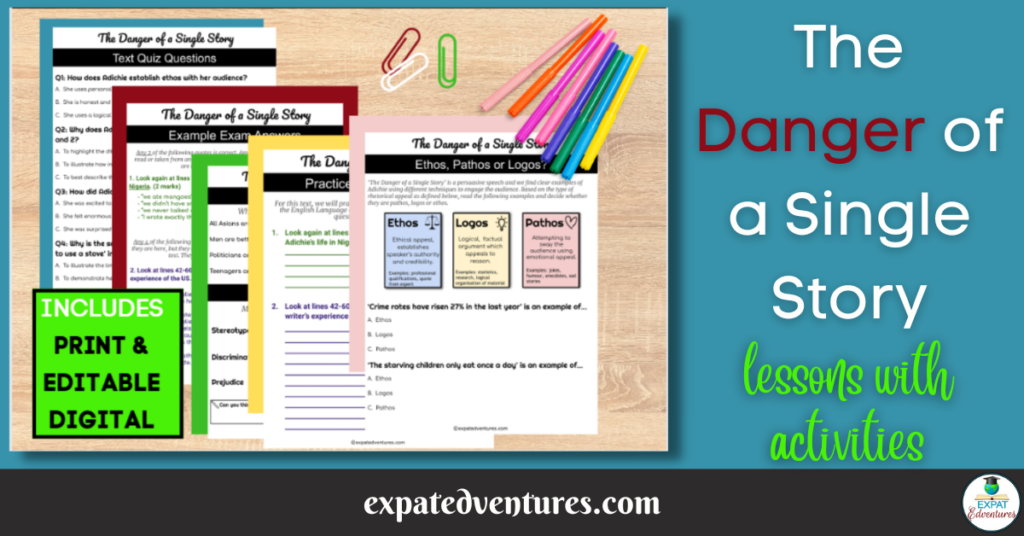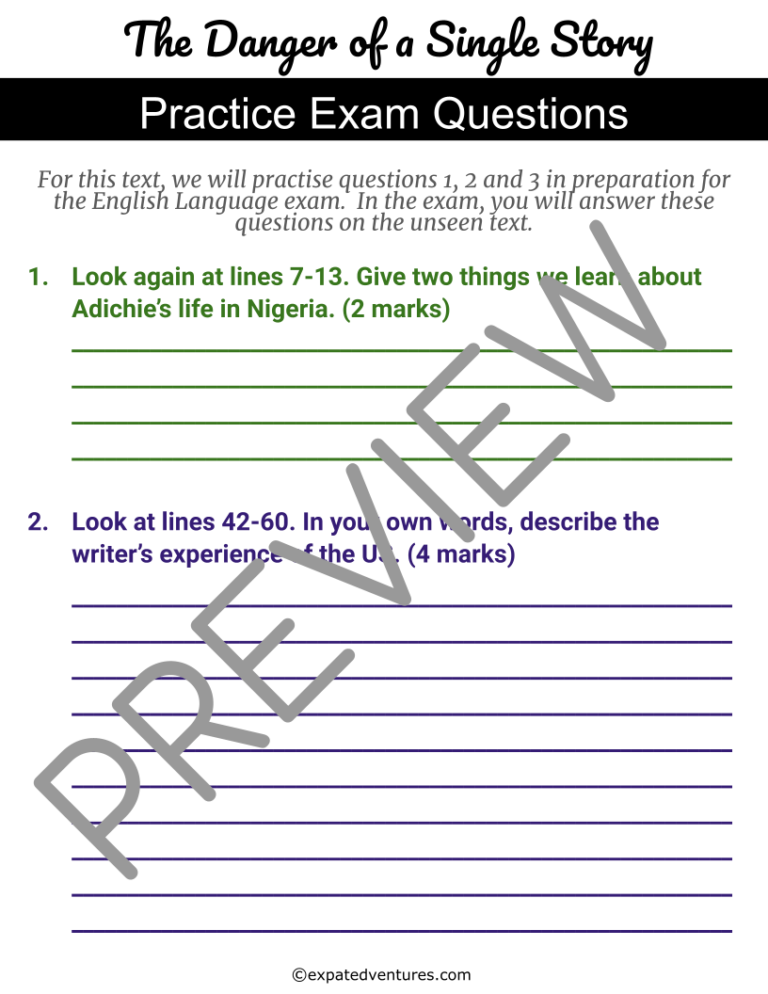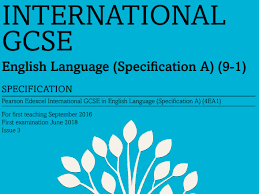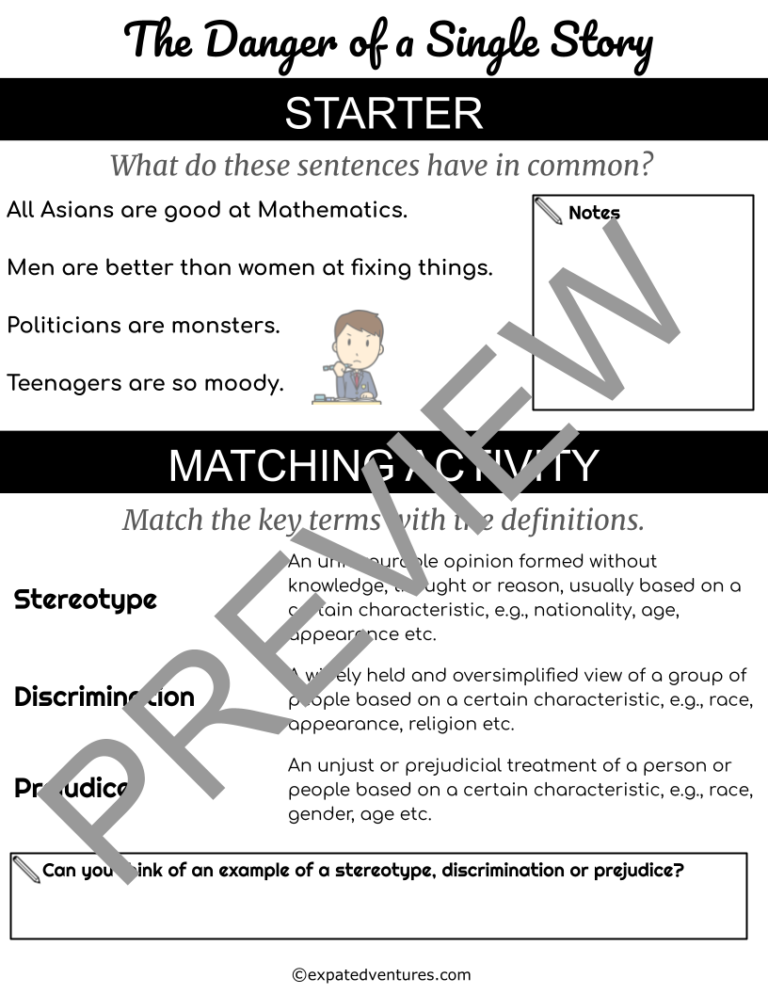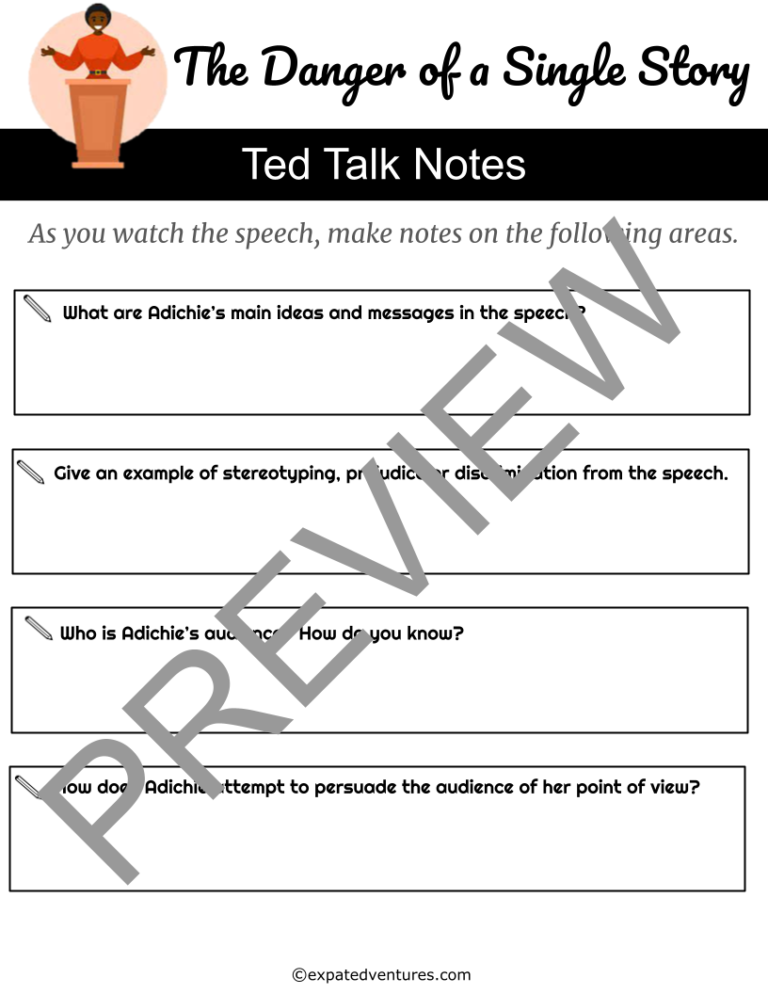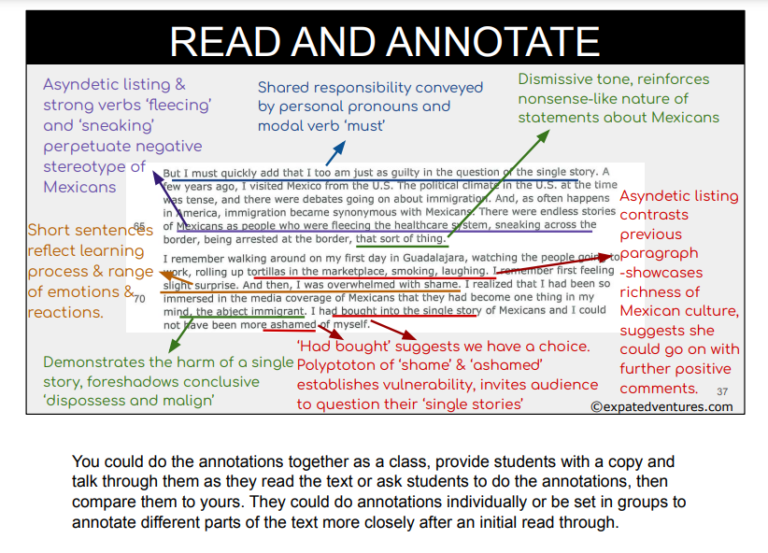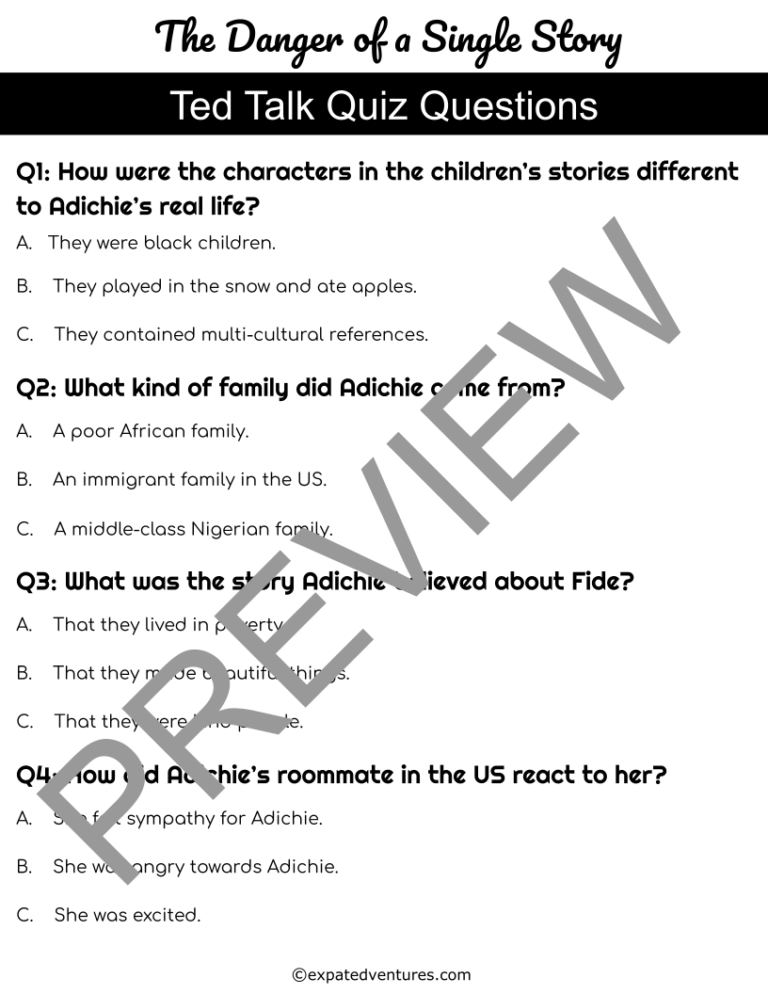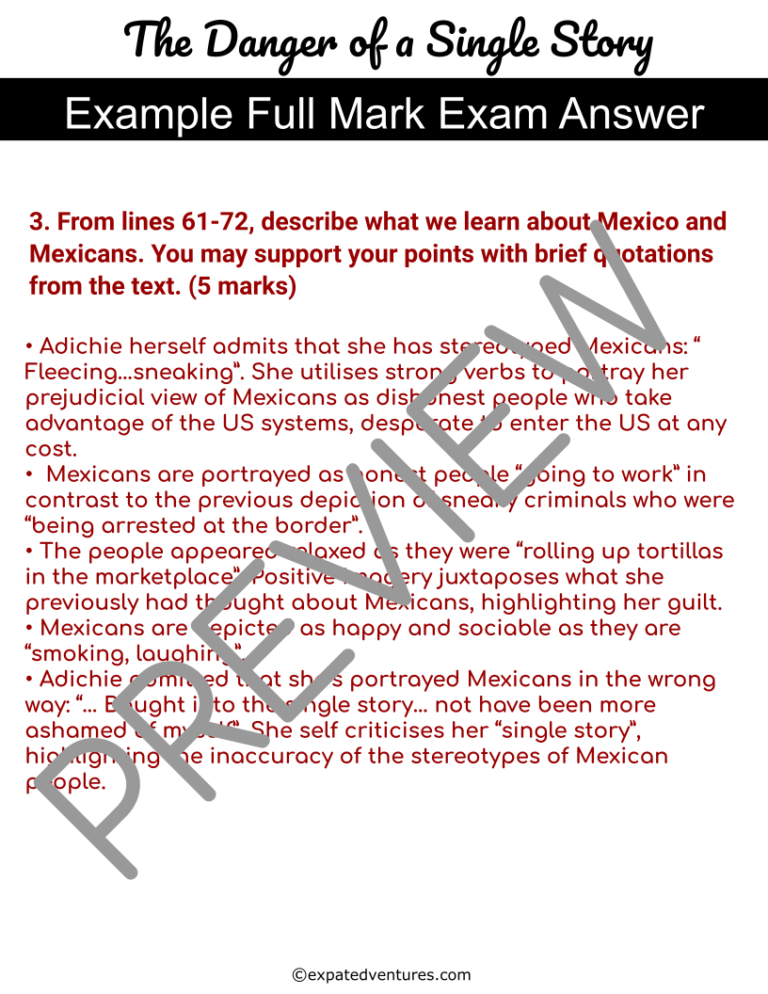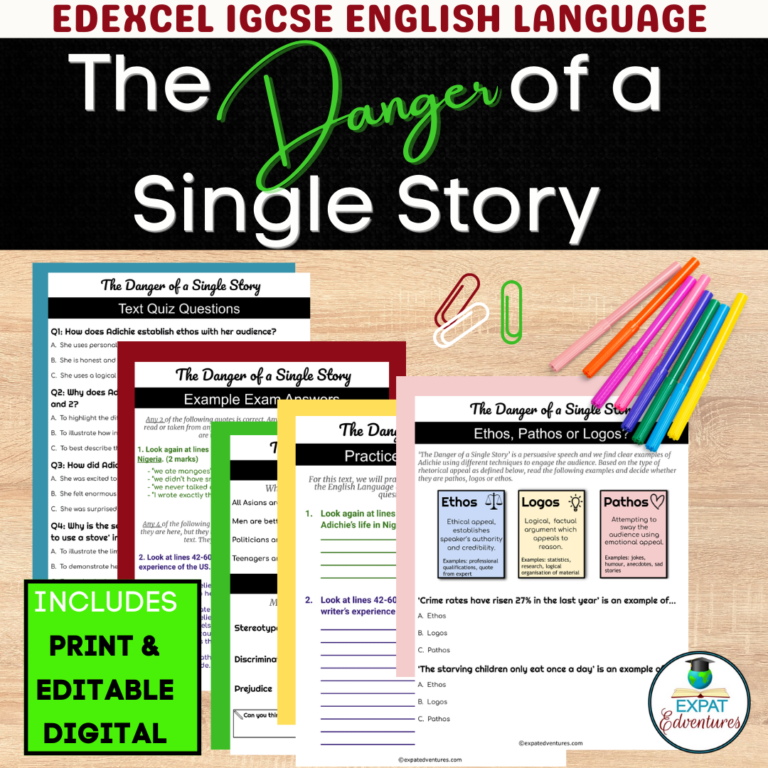‘The Danger of a Single Story’ is a Ted Talk speech by Chimamanda Ngozi Adichie. At the time of writing, it has been viewed 10 million times. It is currently studied as part of the IGCSE Edexcel English Language A exam Section A: Non-fiction texts. It’s engaging and evocative; but how can we support students to capture that in their exam essays? How can we break it down to consider not only the message from a critical stance, but how Adichie achieves that message through persuasive rhetorical techniques? This article takes you through a step-by-step guide for teaching ‘The Danger of a Single Story’ lessons.
Teaching Ideas for The Danger of a Single Story
I’ve created a resource for busy teachers to take you step-by-step through ‘Danger of a Single Story’ lessons from engaging, thought-provoking starter, to evaluating the Ted Talk speech, to analysing and annotating the text, to practising Edexcel GCSE style questions on the text. This resource contains editable Google slides, quizzes with answer keys, exam questions, techniques and model answers and close textual annotations of the whole text.
Edexcel IGCSE English Language A Exam Structure
The 2 hour 15 minutes Edexcel IGCSE English Language Exam is split into Section A and Section B. Section A is the reading assessment and candidates are presented with one of the 10 Anthology non-fiction texts and one thematically linked unseen text. They have 5 questions to answer in Section A:
- A 2 -mark retrieval question. Lifting and copying two brief and relevant quotes from the unseen text is the skill being assessed in this question.
- A 4-mark summary question. Candidates are asked to paraphrase a certain event, character or theme from the unseen text.
- A 5-mark ‘SQUID’ question (it’s an acronym not a slimy sea creature!). Students identify five distinct details from the unseen text and use quotations to support their points.
- A 12-mark extended analytical response on the seen text.
- A 22-mark comparative essay, usually based on the writers’ perspectives, experiences or feelings.
Section B is a writing assessment. Candidates choose between two options, which are normally loosely based on the Section A texts. The text types include a letter, article, speech or leaflet. Both Section A and Section B are equally weighted, worth 45 marks each.
'The Danger of a Single Story' Key Ideas
The main themes of the speech are stereotyping and prejudice – developing a single or narrow story about a person or group of people without considering the many complexities that comprise their identity. I start teaching this lesson by sparking students’ opinions about these issues to hook them into the text.
I present them with stereotypical sentences, such as ‘all Asians are good at Science’, then allow them to discuss, eliciting the concept of stereotyping and initiating a discussion about the effects of stereotypes. The controversy of the stereotypes usually hooks their interest.
Once students have formed an opinion of stereotypes, they match definitions to key terminology associated with ‘The Danger of a Single Story’ – discrimination, stereotype, and prejudice. I feel that giving students knowledge of these concepts before studying the speech enables them to develop a deeper understanding of the main ideas.
Ted Talk Activities
After students have completed this starter activity and I feel that they have a firm grasp of the concepts, we watch the Ted Talk. I give them some questions to guide their notetaking during the viewing and ask them to glean the main ideas of the speech.
To keep students engaged during the speech, I tell them they will be quizzed on it after. This is especially useful for students who tend to get easily distracted or who are not invested in studying for their GCSEs.
The Ted Talk speech quiz can be done as a class via the interactive whiteboard as an assessment-for-learning activity or handed out to students to complete individually. There’s an answer key included with the resource. It’s a good opportunity to discuss students’ reactions to the speech and gauge their initial understanding before moving on to text analysis.
'The Danger of a Single Story' Textual Analysis
Before close textual analysis, I also like to ensure that students’ have a good working knowledge of ethos, pathos and logos so that they can link the persuasive techniques used in the speech to these rhetorical devices. In terms of your planning, this is usually the start of the second lesson in ‘The Danger of a Single Story’ lessons.
When it comes to closely analysing the text of the speech, there are a few ways of approaching the activity. You can read and annotate together with students completing the annotations in real time. Alternatively, you can split students into groups and ask each group to focus on a certain paragraph before feeding back to the class. Or you could read and discuss, then ask students to complete the annotations for homework. There are many ways of approaching close textual analysis; I find that varying the method for different texts keeps students interested through the unit.
'The Danger of a Single Story' Questions and Answers
After analysing the text, I do a quick AFL quiz with students to assess their understanding of the language and structure of the text, then introduce exam practice questions. Quiz questions and answers are available with this resource about the Ted Talk and the close textual analysis. This can be done as a whole class activity on the interactive whiteboard or handed out to students to do in pairs or individually, depending on your time and the nature of your class. I find quizzing students in a fun, low-stakes way breaks up the intensive exam-style teaching of the text, but also gives you an opportunity to gauge students’ understanding during the lessons.
Exam Questions and Example Essays
Even though questions 1, 2 and 3 of Section A of the language paper assess students’ understanding of an unseen text, I still practise these questions for the studied texts. It saves on time when you have 10 non-fiction texts to study in a short time plus the structure of the exam and practice questions. For some of the texts, I give students questions in the style of question 1, 2 and 3, and for other texts, we do question 4 and for some we do the comparative question 5 response.
For ‘The Danger of a Single Story’, I have written questions that are structured similarly to questions 1, 2 and 3 from the language paper and a framework for students to structure their answers, as well as model answers for them to use to either self or peer-assess. I find peer assessment works particularly well for questions 1, 2 and 3 of the language paper, or the lower stakes questions worth fewer marks. Students gain confidence marking these shorter answers which they can then apply to assessing the longer responses.
'The Danger of a Single Story' Activities
I’ve included an optional creative activity. Time-permitting, you could use it as a class activity if you feel that students aren’t connecting with the text, as a homework assignment or an extension activity to challenge students to broaden their perceptions of the text.
'The Danger of a Single Story' Lesson Plan
In a nutshell, my recommendations for teaching this text as an Edexcel examiner and teacher are listed below. You can find editable Google slides and PDF worksheets with answer keys for all the listed activities for ‘The Danger of a Single Story’ in my resource.
- Hook students with an intriguing starter activity
- Use alternative methods to closely analyse and annotate the text
- Quiz students for quick AFL strategy to assess whether they are engaging with the text
- Practise either questions 1-3, question 4 or question 5 from the Language paper
- Study model answers, including examples of typical mistakes students make in the exam responses
- Offer an optional creative activity as homework or an extension to challenge students’ perceptions of the text
Good luck teaching ‘The Danger of a Single Story’ – it’s evocative, engaging and a pleasure to teach in so many ways. Comment below if you can add any useful teaching and learning techniques for this speech.

